Bergen, Norway
We arrived in Bergen on the morning of July 26. Bergen is almost 1,000 years old and was once the main city in Norway. Today it is Norway’s second largest city, after Oslo.
It turned out that our visit was in the middle of a 4 day tall ship race hosted by Bergen this year. This really was a bonus for us, as the tall ships throughout the harbor provided an extra dimension of interest. The downside was that there were HUGE crowds around the harbor; we understood that several hundred thousand visitors were expected for these 4 days and we were there on Saturday, the first non-work day for locals during the race. The crowds did lend a carnival atmosphere to the city. Fortunately, once you got a couple of blocks away from the harbor the crowds thinned substantially.
The tall ships lining the harbor conveyed something of what it must have looked like in the middle ages when Bergen was an important outpost for the Hanseatic League, a trade conglomerate of northern German cities started by the merchants of Lubeck. The Norse fishermen provided them with large quantities of dried cod fish, which they resold into a thriving market throughout northern Europe. So the harbor must often have been filled with fishing and merchant vessels. As we walked into town from the cruise ship dock on the outskirts of the harbor we came to Bryggen, the area where the rich German Hanseatic merchants once had their homes & warehouses. It is a brightly painted row of buildings across the street from the harbor that today houses museums, restaurants & shops. Built of wood, this district has burned down a number of times over the centuries, most recently in 1955, after which extensive archaeological excavations were begun while the buildings were carefully restored to their original condition using period materials & techniques.
Because of the crowds & limited time we passed on the museums, but we did wander around the buildings and narrow alleys of this complex rife with atmosphere.
In an inside courtyard we encountered a huge carved wood figure of a dried cod, presumably a tribute to what was once the bulwark of the local economy. Out front by the harbor a group was performing continuously on what appeared to be a temporary stage. It was all in Norwegian, so we couldn’t tell what it was about, but it appeared to center around comic drinking songs (in the morning!). There were a couple of other stages where there were performances (perhaps a competition) of sea shanties, some of which were in English.
We walked up the hill behind Bryggen to see the Marienkirche (St. Mary’s church), which dates to the 11th century. Unfortunately it was closed for renovation until January so all we could do was walk around the outside. On the hill coming down we came across a statue of Snorri Sturluson, the author of at least one of the Poetic Edda, appropriately carrying a book under his arm.
We passed beyond the end of the harbor, where we saw the fishmarket (which seemed to be a bit curtailed to make room for the ship festival) and several interesting looking buildings, squares & streets branching out, some with sculptures. You can see from the photos that Bergen is built on steep hills rising from the harbor.
We walked up an inclined street to a large pedestrian square that seemed to be a gathering place for families with children. There were a number of oversized games here on the street, including scrabble & legos. There was also an apparent chess master playing many opponents at once & a “living statue,” something you see a lot in Barcelona.
In the center of this square is a large monument to Norwegian sailors through the ages, with one side of the square monument for each age of sailing. The locals call this the “cube of goat cheese.” But its really rather striking, with statues as well as a relief on each of the 4 sides. I don’t really know the names of all four of the periods represented, but I will give my best guess in the picture labels (which, for newcomers, can be seen by hovering your mouse over the picture).
Further up the road is a large park with a lake in the center. There is a fountain in the lake & a lot of colorful flowers around it. At one end there is a music pavilion.
Just beyond the lake we found . . . the library! It is an old castle-like building, with stone carving in and out. Very atmospheric. Built in 1917, it is called the “Bergen Offentlige Bibliotek.”
On the way back we visited the Domkirchen, the Lutheran Cathedral in Bergen. Originally built in the 12th Century, it has been ravaged by fire and rebuilt and expanded several times since. It is open every weekday afternoon, but it was Saturday so the church was closed all day. It was a bad luck day for us with churches.
There were public sculptures in town of Bergen’s three patron saints of the Arts. Composer Edvard Grieg lived here & you can visit his house outside of town. Henrik Ibsen was a director at the National Theater here during the 1850’s. And Ole Bull, a violinist, was not only a great patron of the Arts but the Elvis and Beatles of his time: it is said that women fainted when he played the violin. Imagine what he could have done with an electric guitar!
At the top of a wide boulevard with colorful flowers leading up from the lake & the Ole Bull monument is the National Theater, where the statue of Ibsen is located. It is a rather elaborate 19th Century arte nouveau building, rather attractive in its style. From the dates on its facade it appears that “Den Nacionale Scene,” as it is called, was founded in 1850 & this building erected in 1909.
As you can already see, Bergen was vibrant with all kinds of colorful flowers. So here are just a few of the flowers we saw.
So by this time we were pretty tired. It was a long & (surprisingly) hot day fighting crowds with lots of walking. So we headed back toward the Veendam. Just before we reached it we passed an old fortress called Haakon’s Hall & Rosenkrantz Tower. These were originally part of the defenses of Bergen’s castle during the middle ages & Renaissance (although the Hall served ceremonial purposes). One reminder of the tension that was inevitable between the Germans in Bryggen & the Norwegians is what appear to be cannon holes in the top of the tower, some of which face Bryggen instead of the harbor entrance. As I said, we were tired & there were crowds, so we didn’t go inside.
So, with a final look at Bergen harbor, we set out to sea. The evening was eventful. I had my first Mojito ever & it turned out to be a very happy drink. Then there was a gorgeous sunset, the first of this trip (at least on our side of the ship); most evenings up to then had been too foggy. At the end of the sunset was a long period of beautiful pink and light blue, and we even saw whales (although you usually see little more than their backs & tails when they surface). It was the nicest night at sea so far, & a good way to end a very full & interesting day in Bergen.

















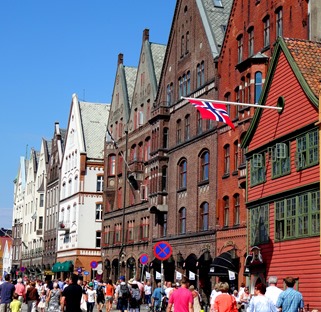



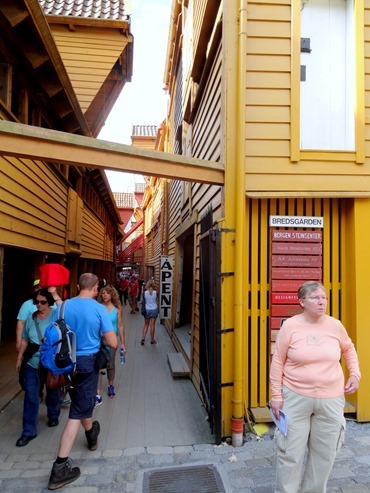
















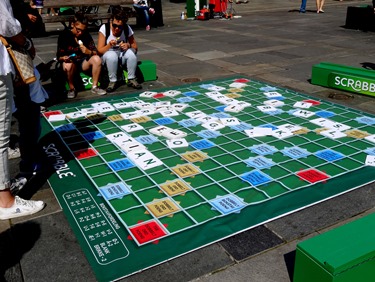

















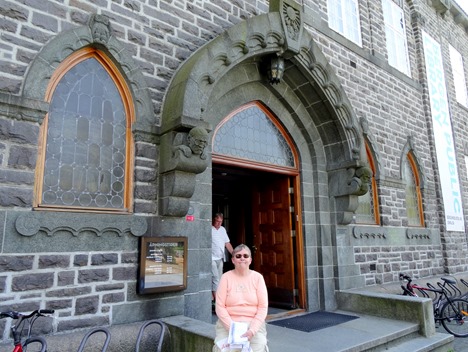











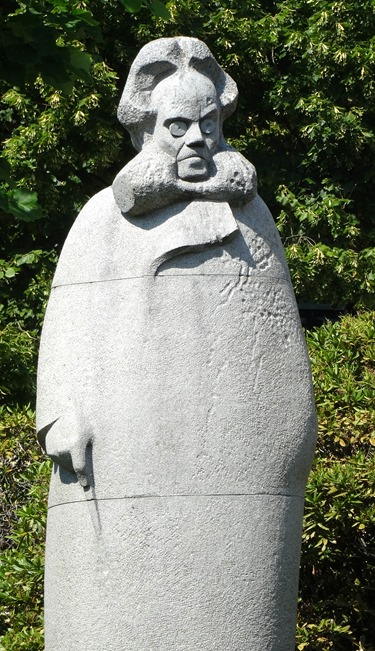

























That’s a STRANGE-looking Mojito, Rick . . . too blue! For a real Mojito, you have to come to Miami. Let us know the next time you’re in South Florida, and we’ll treat you to one.
August 13, 2014 at 3:57 pm
Yes, its a Blue Coco Mojito. It was very good. I had a regular one later & it was good too, but this one was better. On the other hand, I’m sure having one with you folks in south Florida would be even better!
On Wed, Aug 13, 2014 at 3:57 PM, BADER JOURNAL wrote:
>
August 13, 2014 at 4:03 pm
Wow–wonderful photos!! Indeed an interesting day. Thanks for sharing your trip with us.
August 13, 2014 at 4:08 pm
At last! You finally stopped someplace that I actually once visited, although I was there so many decades ago I had largely forgotten what it looked like. I am particularly pleased to get reacquainted with a city I recall enjoying. Thanks for reawakening my memories.
August 16, 2014 at 11:49 am